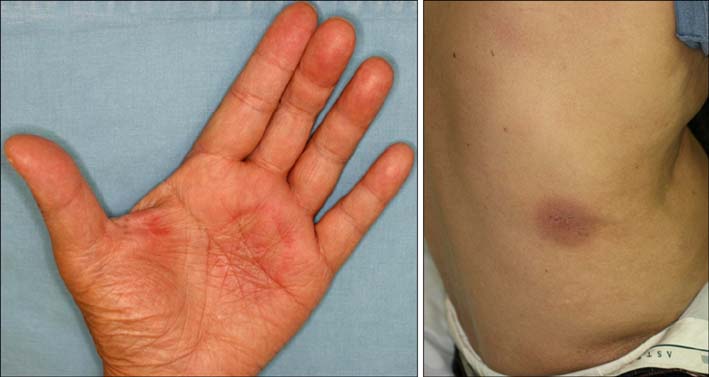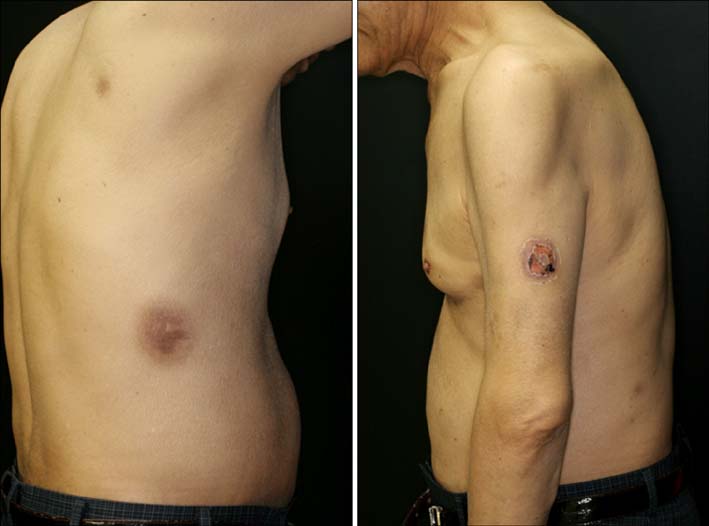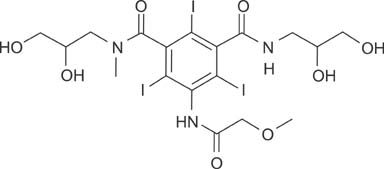Ann Dermatol.
2011 Sep;23(Suppl 1):S33-S35. 10.5021/ad.2011.23.S1.S33.
Fixed Drug Eruption due to Iopromide (Ultravist(R))
- Affiliations
-
- 1Department of Dermatology, Seoul St. Mary's Hospital, College of Medicine, The Catholic University of Korea, Seoul, Korea. yymmpark6301@hotmail.com
- 2Regional Phamacovigilence Center, Seoul St. Mary's Hospital, College of Medicine, The Catholic University of Korea, Seoul, Korea.
- KMID: 2156746
- DOI: http://doi.org/10.5021/ad.2011.23.S1.S33
Abstract
- A 69-year-old male presented with several painful erythematous patches on both palms and trunk several days after receiving iopromide (Ultravist(R), Shering, Berlin, Germany). A fixed drug eruption (FDE) due to iopromide was suspected clinically. However, at that time, the patch test with iopromide at the lesion site gave negative results. Three years later, the patient was mistakenly administered iopromide again and patches with vesicles recurred on the same sites as well as on the genitalia. This episode was repeated once again after 1 year. In all episodes, the skin lesion resolved after application of topical steroids. Although a patch test with iopromide was negative in our case, we made a diagnosis of FDE due to iopromide because the skin lesions occurred again at the previously involved area after re-exposure to iopromide. To date, only three cases of FDE caused by non-ionic monomers have been documented in the English literature. Herein, we report on an interesting case of FDE caused by iopromide.
MeSH Terms
Figure
Cited by 1 articles
-
Iodinated contrast media-induced fixed drug eruption
Jisu Shim, Soojie Chung, Gun-Woo Kim, Kyoung-Hee Sohn, Ju-Young Kim, Hye-Ryun Kang
Allergy Asthma Respir Dis. 2015;3(5):375-379. doi: 10.4168/aard.2015.3.5.375.
Reference
-
1. Shear NH, Knowles SR, Shapiro L. Wolff K, Goldsmith LA, Katz SI, Gilchrest BA, Paller AS, Leffell DJ, editors. Cutaneous reactions to drugs. Fitzpatrick's dermatology in general medicine. 2007. 7th ed. New York, USA: McGraw-Hill;359–360.2. Böhm I, Medina J, Prieto P, Block W, Schild HH. Fixed drug eruption induced by an iodinated non-ionic X-ray contrast medium: a practical approach to identify the causative agent and to prevent its recurrence. Eur Radiol. 2007. 17:485–489.
Article3. Christiansen C. X-ray contrast media--an overview. Toxicology. 2005. 209:185–187.
Article4. Watanabe H, Sueki H, Nakada T, Akiyama M, Iijima M. Multiple fixed drug eruption caused by iomeprol (Iomeron), a nonionic contrast medium. Dermatology. 1999. 198:291–294.
Article5. Webb JA, Stacul F, Thomsen HS, Morcos SK, et al. Members Of The Contrast Media Safety Committee of The European Society of Urogenital Radiology. Late adverse reactions to intravascular iodinated contrast media. Eur Radiol. 2003. 13:181–184.
Article6. Schick E, Weber L, Gall H. Delayed hypersensitivity reaction to the non-ionic contrast medium iopromid. Contact Dermatitis. 1996. 35:312.
Article7. Yamauchi R, Morita A, Tsuji T. Fixed drug eruption caused by iopamidol, a contrast medium. J Dermatol. 1997. 24:243–245.
Article
- Full Text Links
- Actions
-
Cited
- CITED
-
- Close
- Share
- Similar articles
-
- Comparative evaluation of pain between angiografin 60 and ultravist 300 during peripheral angiography
- A Case of Generalized Fixed Drug Eruption due to Mefenamic Acid
- Generalized Multiple Fixed Drug Eruption
- Nonpigmenting Fixed Drug Eruption due to Codeine
- A Case of Fixed Drug Eruption Due to Acetaminophen




